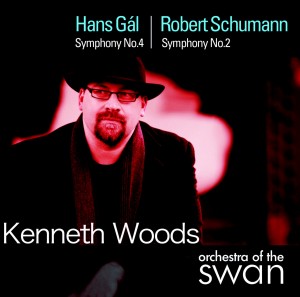Musicologist and radio host Bernard D. Sherman has posted a review of the new Orchestra of the Swan recording of Gal’s Symphony no. 4 and Schumann’s Symphony no. 2 on his blog. His books “Performing Brahms” and “Inside Early Music” are volumes every conductor should own.
Click here to order from Amazon.co.uk
Click here to order from Amazon.com
A sample follows:
Schumann 2 is one of the hardest symphonies for interpreters. It’s hard not to mangle the syntax by getting the phrasing wrong; it’s hard not to bury the winds at certain points or to lose sight of other important lines – there’s so much going on. Yet I’ve heard performances where you can hear it all but don’t really want to, as the phrases have no life or shape and it all just sounds “notey.” Quite the contrary here. Part of why is the insight, nicely explained in the booklet, into how Schumann conveyed meaning through allusion to other great music: Woods points to the allusions to Haydn’s 104th, the Trio Sonata from Bach’s Musical Offering, Mozart’s Long live Sarastro! from theMagic Flute, Beethoven’s To the Distant Beloved, and one of Schumann’s own songs, Dedication. Sounds academic but it’s not; it lets Woods and his players weight what is more or less important. (And if you’re a classical music buff, you will hear all the allusions and they will be meaningful to you.) All the many things going on form a coherent discourse in this performance. Another ingredient is how they build fearlessly not only to one climax but to an overall climax for the whole work. There is also the excellence of the players: listen to the oboe solo in the third movement, which – as a whole – receives a truly poetic performance.
But let me harp again on the divine madness – the insane glee, the visceral delight. When we’re talking about Schumann the words “insane” and “manic” are fraught, since he was one of the first great composers to be retrospectively diagnosed as bipolar… But I mean something else – that Fricsay/ Naida Cole demonic possession by Pan. Other examples: Lipatti playing Ravel’s Alborado; Glenn Gould’s first Goldbergs; any number of recordings of Bernstein or Furtwangler. Part of it, in Swan/ Woods’ first two movements, comes from speed (Schumann’s MMs are famously fast); yet some speedy performances have sounded merely rushed, as if the players were uncomfortable and pushed. What I want, when we’re talking speed, is that sense of possession. In this performance the speed is not hectic but ecstatic. YES!
Divine madness, like this, must be experienced. On top of this, you get what is effectively (I’ve never heard it before) a new work: the Hans Gal Fourth, written in 1975, when it would have seemed “backward” in idiom -ha! The web page notes that it is pastoral and lyrical in style, which it is, but I had to read the booklet and understand the pain behind this music to find my way past its challenges, and I had to give it a few listens. Give it a chance: it will come to move you deeply. And it’s hard to imagine a better performance. If my blog had a star system, this disc would certainly get 5 of them.

I second and third this review. I’ll presumably have more to say about it at some point, but suffice it to say it’s been thoroughly enjoyed by me so far. You, sir, are the man.
Hey Erik- Thanks for weighing in. I do hope you have more to say, because the world needs more of your blogs posts, regardless of the subject.